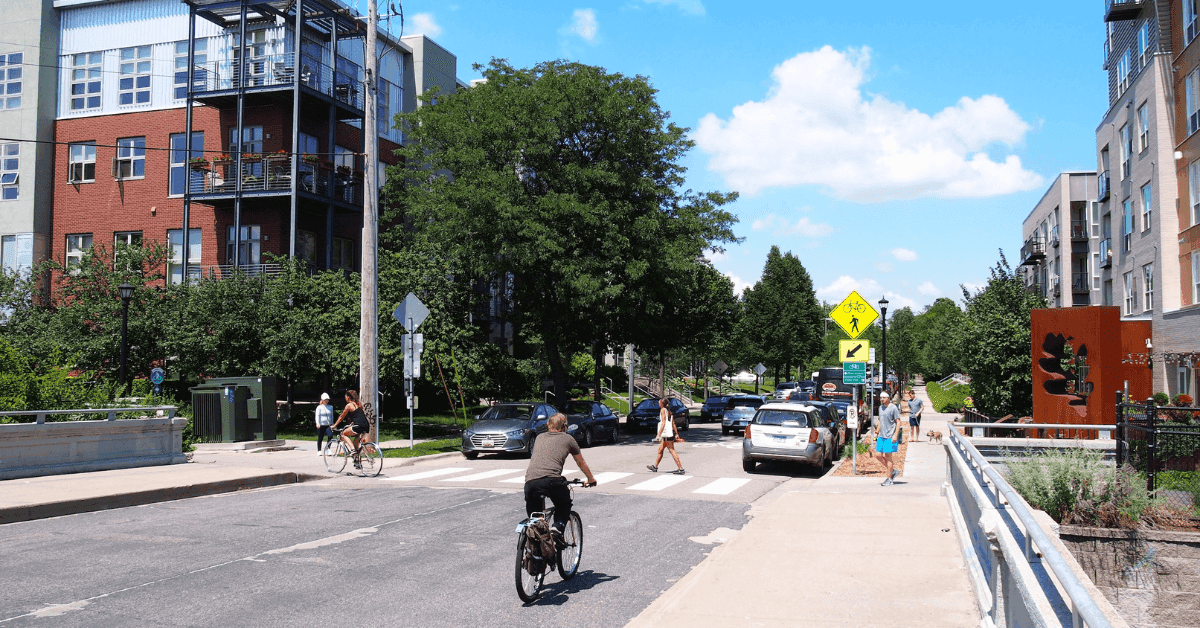
News
By Raveena John, September 18, 2024
The connective tissue of our cities—the streets, roads, and transportation networks that enable people to move from place to place—are not exempt from the influence of parking minimums.

Complete Streets is the idea that we need to build our roads to prioritize people, not cars, so that we can all safely and comfortably travel where we want and how we want, be it walking, biking, rolling, driving, or using transit. Parking minimums, which place a heavy priority on cars, have the potential to undermine efforts to successfully implement Complete Streets. However, cities can and have overcome the challenges imposed by these antiquated restrictions.
What are the impacts of off-street parking requirements on the streetscape and the roads themselves? How do these requirements for storing cars affect how people can use the street? As we’ve seen earlier in this series, parking minimums influence travel behavior by incentivizing people to drive. People moving from place to place use their cars to take them from parking lot to parking lot. This furthers car dependence and increases the amount of cars on the streets, which crowds out other modes of transportation. The dominance of cars and parking can discourage the development of infrastructure for people walking, biking, or taking transit.
With such a car-centric status quo, it can be hard to imagine an alternative. Even if a community successfully used the Complete Streets approach to install safe bike lanes, welcoming transit stops, and comfortable sidewalks, if the surrounding area is full of off-street parking, people are still navigating a space built mostly for cars. As Jonathan Levine, professor of urban and regional planning, said to NPR, “Who wants to walk by a bunch of parking lots to get to your destination?” But with the removal of parking minimums, the possibility for redeveloping or creatively reusing existing parking lots can enhance the destinations surrounding the Complete Streets, further encouraging people to use active transportation or transit.
But what about street parking? Proposing to remove parking minimums can receive pushback due to concerns about increasing the demand for on-street parking and causing more “cruising.” There are so many great things we could be doing with our public right-of-way other than providing parking for private vehicles, so what can be done to address this concern?
First, it’s important to recognize that removing parking minimums doesn’t automatically remove existing parking lots (though there are other excellent strategies and initiatives to reduce the amount of pavement in our cities). Updating zoning codes to expressly allow infill development on existing parking lots could help turn excess parking space into housing options and businesses—development that could better serve the community. Regardless of the changes desired, any impacts on parking availability will not be immediate, so there is time for a city to thoughtfully plan their approach.
Second, cities should use this opportunity to consider all the potentially competing uses of the curb. Curb management is a big topic right now—this land is valuable and there is growing understanding that it should no longer be assumed as free storage for private vehicles.
Finally, this is an opportunity to consider how we make choices based on the options available to us and how investing in infrastructure for more than just cars can shape our cities. If parking, the end of all car journeys, is harder while walking, biking, or using transit is easier, safer, and even more fun, more people will choose a mode other than a car. This mode shift benefits the traveling person (physical activity, joy), the surrounding community (air quality, neighborhood vibrancy), and beyond (reducing carbon emissions), and can be a central benefit in rethinking parking and our streets.
Learn more about the impacts of parking minimums and what we can do to address them by visiting the rest of our series, Parking minimums: A barrier to smart growth.
Related News

© 2026 Smart Growth America. All rights reserved
Site By3Lane Marketing













